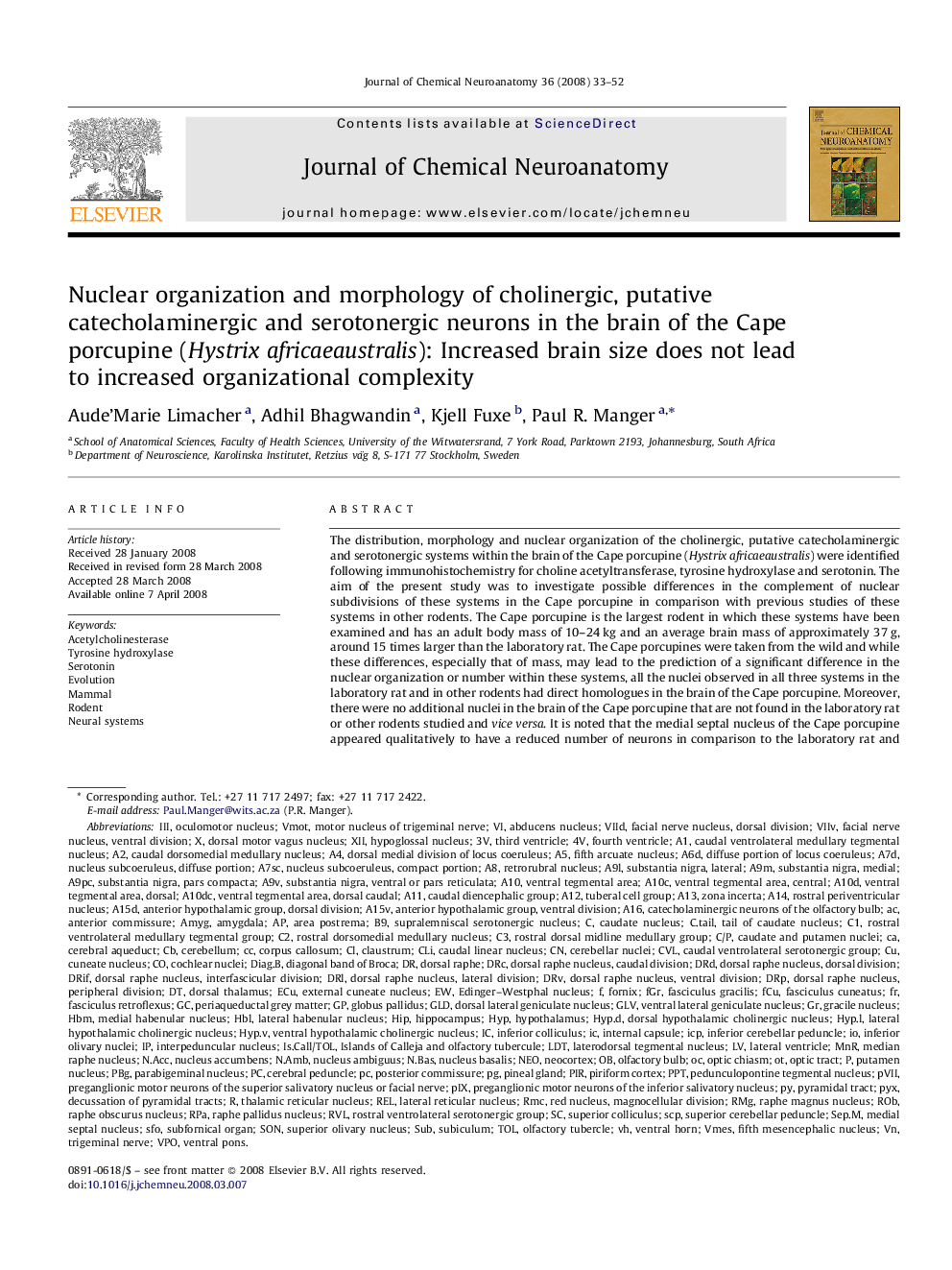| Article ID | Journal | Published Year | Pages | File Type |
|---|---|---|---|---|
| 1989395 | Journal of Chemical Neuroanatomy | 2008 | 20 Pages |
Abstract
The distribution, morphology and nuclear organization of the cholinergic, putative catecholaminergic and serotonergic systems within the brain of the Cape porcupine (Hystrix africaeaustralis) were identified following immunohistochemistry for choline acetyltransferase, tyrosine hydroxylase and serotonin. The aim of the present study was to investigate possible differences in the complement of nuclear subdivisions of these systems in the Cape porcupine in comparison with previous studies of these systems in other rodents. The Cape porcupine is the largest rodent in which these systems have been examined and has an adult body mass of 10-24Â kg and an average brain mass of approximately 37Â g, around 15 times larger than the laboratory rat. The Cape porcupines were taken from the wild and while these differences, especially that of mass, may lead to the prediction of a significant difference in the nuclear organization or number within these systems, all the nuclei observed in all three systems in the laboratory rat and in other rodents had direct homologues in the brain of the Cape porcupine. Moreover, there were no additional nuclei in the brain of the Cape porcupine that are not found in the laboratory rat or other rodents studied and vice versa. It is noted that the medial septal nucleus of the Cape porcupine appeared qualitatively to have a reduced number of neurons in comparison to the laboratory rat and other rodents. The locus coeruleus of the laboratory rat differs in location to that observed for the Cape porcupine and several other rodent species. The Cape porcupine is distantly related to the laboratory rat, but still a member of the order Rodentia; thus, changes in the organization of these systems appears to demonstrate a form of constraint related to the phylogenetic level of the order.
Keywords
Corpus callosumDRCRMCECUPPTICPVPOSCPFGRA12SFONEOHBMRELDRDTOLLDTFasciculus retroflexusAMYGexternal cuneate nucleusIIIDRPCVLGLDXIIPyXCLiHYPFCUDRVRPAPBGC/PVMEsA13A10PIXA14DRLA11RVLA16RMGHBLN.AccA6dA7dA7scA9lA9mA9pcA9vA10cA10dA10dcA15dA15vVIIvsubstantia nigra, lateralsubstantia nigra, medialVmotVIIdcaudal dorsomedial medullary nucleusnucleus subcoeruleus, diffuse portionnucleus subcoeruleus, compact portioncatecholaminergic neurons of the olfactory bulbsupralemniscal serotonergic nucleusrostral dorsomedial medullary nucleuscaudal ventrolateral serotonergic grouppVIIDiag.BHyp.dHyp.lHyp.vIs.Call/TOLN.BasSep.mdorsal motor vagus nucleusfasciculus gracilisMnRAmygdalasuperior cerebellar peduncleAcetylcholinesteraselateral ventriclethird ventriclefourth ventriclePirdorsal thalamusabducens nucleussubstantia nigra, pars compactaOlfactory tubercletyrosine hydroxylaseRodentPyramidal tractoptic tractDorsal raphé SUBSubiculumSuperior colliculusinferior cerebellar peduncleSerotonincerebral peduncleNeural systemsventral hornarea postremaDRiftrigeminal nerveSubfornical organRObPineal glandSONEvolutionfornixdiffuse portion of locus coeruleuspiriform cortexcerebral aqueductPeriaqueductal grey matterclaustrumCerebellumHIPventral tegmental area, centralventral tegmental area, dorsal caudalventral tegmental area, dorsalzona incertaventral tegmental areaN.AmbneocortexEdinger–Westphal nucleusNucleus accumbenscuneate nucleushypoglossal nucleusinterpeduncular nucleusoculomotor nucleusParabigeminal nucleusThalamic reticular nucleusnucleus ambiguussuperior olivary nucleusinferior olivary nucleinucleus basalisretrorubral nucleuspedunculopontine tegmental nucleusLateral habenular nucleusCaudal linear nucleuscaudate nucleusmedian raphe nucleusraphe pallidus nucleusraphe magnus nucleuslateral reticular nucleusmedial septal nucleusgracile nucleusmedial habenular nucleuscaudal ventrolateral medullary tegmental nucleusraphe obscurus nucleuscerebellar nucleidorsal lateral geniculate nucleusrostral periventricular nucleuslaterodorsal tegmental nucleusventral lateral geniculate nucleuslateral hypothalamic cholinergic nucleusventral hypothalamic cholinergic nucleusdorsal hypothalamic cholinergic nucleuscochlear nucleiHypothalamusHippocampusMammalfifth arcuate nucleusolfactory bulboptic chiasmPosterior commissureanterior commissureInferior colliculusinternal capsulecaudal diencephalic grouprostral ventrolateral medullary tegmental grouptuberal cell groupDiagonal band of Brocaanterior hypothalamic group, ventral divisionanterior hypothalamic group, dorsal divisionGlvGlobus pallidus
Related Topics
Life Sciences
Biochemistry, Genetics and Molecular Biology
Biochemistry
Authors
Aude'Marie Limacher, Adhil Bhagwandin, Kjell Fuxe, Paul R. Manger,
